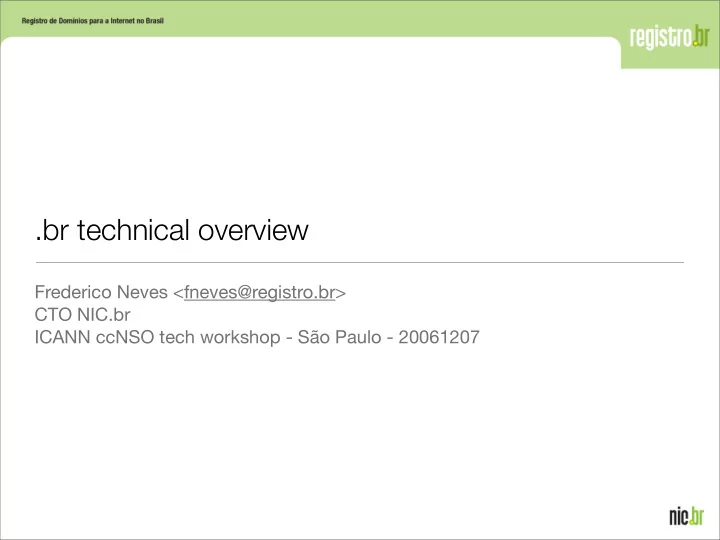

.br technical overview Frederico Neves <fneves@registro.br> CTO NIC.br ICANN ccNSO tech workshop - São Paulo - 20061207
.br brief history and numbers • Started public registration in 1996 with the commercial Internet in Brazil • In 1998 with 30k domains changed to a completely automated registration system with a 100% re-registration phase (took 8 months) • Today 1M domains distributed on 800k owners • Net grow ~170k year (last 3 years) • 26 people working directly with the registry (12 cs, 7 eng, 7 noc) • Daily updated stats at: http://registro.br/estatisticas.html 2
Foundation • 100% Based on Free Software and Open Standards • OO technology • Persistence using RDB • Solid base - evolved in the last 8 years still maintaining fundamental design principals. Biggest changes were: • IP distribution system; IPv6; IDN; EPP and a myriad of registration rules (release process, etc) 3
Object Model ISP 1 n 1 n Contact Entity 3 1 n Domain n 4
Software Development • Environment • SVN • EMACS • G++ • STL, OpenSSL, GD, XERCES++, others 5
Data Replication Schema FE/BE systems XFRD Whois (EPP , WEB) Read Master Load Ext. Backup Backup 6
.br EPP protocol extensions • Extension for the Contact Mapping (RFC3733) to add a unique external ID (CNPJ/CPF), responsible, contact handle and attorney • Extension for the Domain Mapping (RFC3731) to add subordination of domain names to Registrant object, ticket support, automatic renewal and the release process • More info at: • http://registro.br/epp/index-EN.html (protocol) • http://registro.br/info/epp/ (ISPs) 7
DNS QuasiOnLine Publication • From 8 hours to 30 minutes • XFRD server • A more efficient system (propagating only changes) • on a 24h period normally less then 1% of changes • Included journal of changes on the provisioning system • Journal read every 30’ • Optimized for [AI]XFR • Designed for the future 8
XFRD design [1] Zone Info (Full / Journal) [2] Update Publishing Flags + SOA version [3] Secure Zone representation on Disk DataBase Provisioning [4] Forks New Hidden Master Servers (zone/Journal) [5] Notify Auth Server Noti er 2 1 fork 5 AuthServer XFRD BIND/NSD 4 fork 3 Server Disk DNS QuasiWireFormat (Zone/Increment) 9
DNS publishing • Aggregated of 35kq/s • 5 delegated servers [a-e].dns.br • 3 inside the country (São Paulo, Rio de Janeiro e Brasília) • 2 outside (US, GR) • Moving all of them to clusters of machines • Multiples Routers, Switches and Servers per cluster,Anycast “in the local” based on ECMP balancing • 2 New sites entering in production • DENIC (substituting GR), KRNIC 10
Software Infrastructure • OS FreeBSD/Linux/OpenBSD • Basic Services - Apache, Postfix • MUA Mutt with lisp software to deal with CS • Monitoring - RRDTool , Nagios • DNS - BIND e NSD • Backup - Bacula 11
Physical Infrastructure • 80m 2 data center (30 x 44U racks space) • 1+1 (60kVA) UPSs • 1 Power Generator (360kVA) • 2+1 (45 TR) Cooling Systems • CFTV + Proximity cards + Biometric • Fire Suppress system • Fire resistant safe for backups 12
Network Infrastructure • Fully redundant L2 network • 3 Transit provider • 20+ Peering Agreements 13
Questions ? Thank You ! 14
Recommend
More recommend